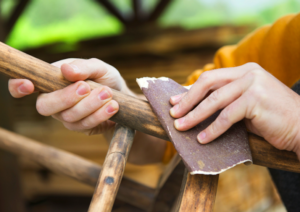As a professional or a hobbyist, one of the power tools you simply must have is an orbital sander. But if you’re new to the world of sanding, you’re going to have a few things to learn. One of the things you must always know is which grade to use. To the absolute newcomer, it can be challenging to wrap your head the way grit size is graded, and what grits are best for which applications. Today, we’re going to give you a brief overview of abrasive grit grades.

Whether you’re a professional or a hobbyist, it pays to learn a thing or two about abrasives. Here is an overview of grit grades.
What’s up with those numbers?
Before we delve into the applications of various grit grades, let’s take some time to talk about the grading system itself.
On most commercial abrasives, you should see a number near the product name preceded by the letter ‘P.’ This is your grit grade. The ‘P’ in front of it signifies that it has been graded in accordance with FEPA grit sizing standards.
Let’s take a look at one of the many Festool abrasives we have for sale: the abrasive mesh for plaster and dispersion fillers with a diameter of 225 mm. The first product on the page has a grit grade of 100, and they go all the way up to 320.
The higher the value you see, the higher the number of sharp particles on a square inch of the abrasive. So if it has a high number it is fine, and if it has a low number it is coarse.
Coarse Grades
We’re going to start with the lower end of grit grades. Typically, these would be between 40 and 60, but coarser grades do exist. Coarsely graded sandpaper can effectively handle some simple tasks such as removing paint, rust, and other debris.
Medium Grades
An abrasive with a grit value between 60 and 120 would qualify as having medium coarseness. This grit level can successfully handle some shaping of wood, especially for such purposes as rounding corners. It may also be a good pick for the first sanding of soft woods.
Fine Grades
There is a wide range of variation among fine grades. For most people’s purposes, anything from 120 to 280 will provide all the fineness they need. This can handle anything from general purpose sanding to smoothing the finishes between coats of paint. Most people will not need to go much higher than about 220.
Still, even finer abrasive grit grades exist, commonly going up as high as 600. This can be useful for polishing other materials like ceramic or stone. Grit grades on the higher end of this spectrum are not typically used for wood.
Hardwood Flooring from Jason Brown Wood Floors
At Jason Brown Wood Floors, our commitment to quality installation is clear in all that we do, which is why our customers consistently rate us as one of the top contractors in the region. We have been awarded Baltimore Magazine’s Best of Baltimore Award 4 times and have been proudly serving the Baltimore Area for over 16 years. If you’re ready to speak with someone about your hardwood flooring project, we want to hear from you! Contact us at 410-668-9131 or send us a message here.
Jason Brown Wood Floors is also your convenient dealer of high-quality, professional grade power tools. We offer brands that tradespeople trust most for the job. Come check out our Bel Air showroom to browse the in-stock selection of products and tools by Festool, Freud, Diablo, Shaper, and Mirka.
Keep up with us on Facebook, Twitter, Pinterest, Houzz, and YouTube, and check out our blog for more news and information!


